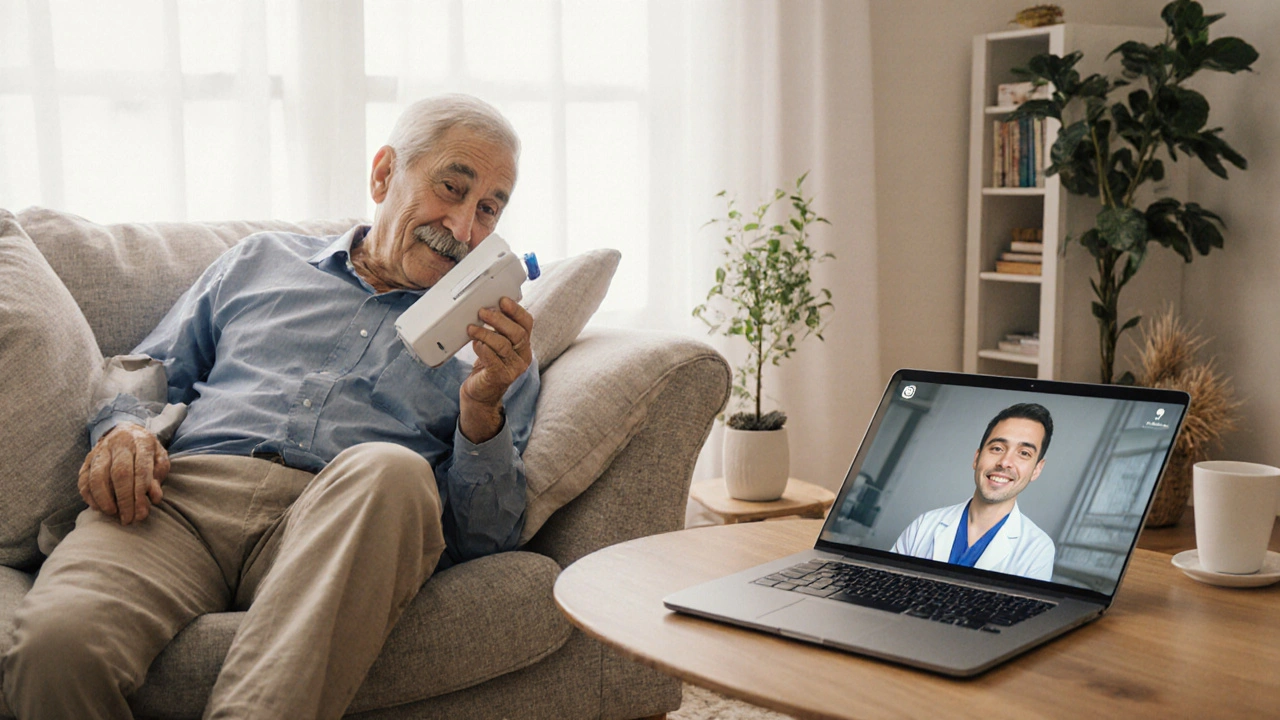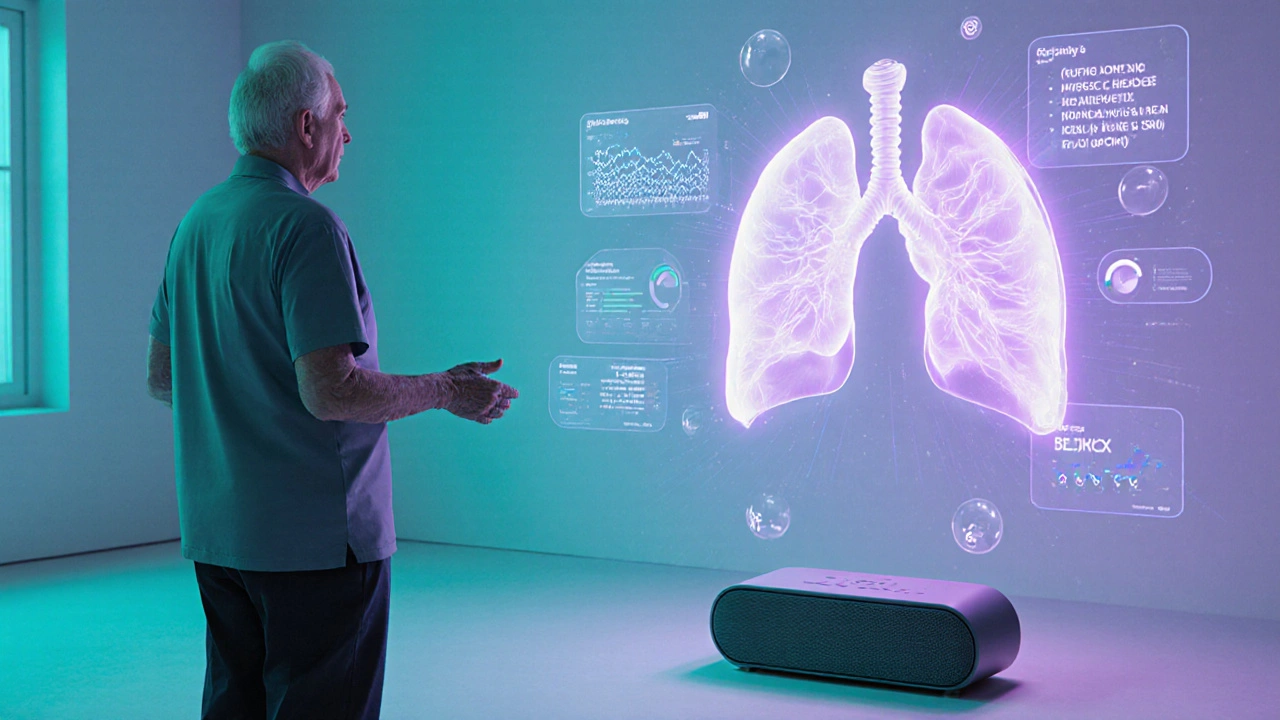How Telemedicine Improves COPD Care: Benefits for Patients
 Oct, 12 2025
Oct, 12 2025
COPD Telemedicine Cost Savings Calculator
Calculate Your Savings
See how telemedicine could save you time and money compared to traditional COPD care.
Results
Enter your values above to see your potential savings
Based on 2024 Medicare data: Each tele-COPD encounter saves $150 vs emergency visits. Typical annual savings range from $1,200 to $1,500 for patients using telemedicine.
Imagine being able to see a lung specialist from your couch, get your inhaler dose adjusted in real time, and avoid a trip to the emergency room-all without leaving home. That’s the promise of telemedicine for COPD, and it’s no longer a futuristic idea.
What Telemedicine Really Is
When we talk about Telemedicine is the use of digital communication tools-video calls, messaging, remote monitoring devices-to deliver clinical health services at a distance, we’re describing a technology that bridges the gap between patients and providers. It isn’t just a video chat; it includes data‑driven tools that let clinicians see real‑time lung function, medication adherence, and lifestyle factors.
Understanding COPD: The Challenge Patients Face
Chronic Obstructive Pulmonary Disease is a progressive lung condition marked by airflow limitation, frequent flare‑ups, and a high risk of hospitalization. In the United States alone, more than 16 million adults live with COPD, and exacerbations cost the health system billions each year. Traditional care models-scheduled office visits and occasional pulmonary function tests-often miss early warning signs, leading to avoidable admissions.

Why Telemedicine Makes Sense for COPD
Remote care aligns perfectly with the needs of COPD patients for three core reasons:
- Continuous monitoring: Devices can capture lung function data daily, spotting declines before symptoms worsen.
- Immediate access to expertise: Specialists can review data and intervene within hours, not weeks.
- Reduced travel burden: Many patients struggle with mobility; eliminating trips saves time, money, and exposure to infections.
These three pillars form the backbone of the benefits we’ll explore next.
Key Benefits of Telemedicine for COPD Patients
- Early Detection of Exacerbations
With Remote Monitoring is the use of connected devices-like Bluetooth spirometers and pulse oximeters-to transmit physiological data to clinicians, clinicians can spot a drop in FEV1 or oxygen saturation within minutes. A 2023 multi‑center study showed a 30% reduction in hospital admissions when remote monitoring alerts were acted upon within 24 hours.
- Personalized Medication Management
Data from remote devices feed into medication algorithms. For example, if a patient’s peak flow falls below a preset threshold, the care team can adjust bronchodilator dosage via a secure messaging platform, preventing a full‑blown flare.
- Access to Virtual Pulmonary Rehabilitation
Pulmonary Rehabilitation is a supervised program of exercise, education, and behavior change designed to improve the physical and emotional condition of people with chronic respiratory disease traditionally requires patients to travel to a clinic three times a week. Telehealth platforms now deliver live‑streamed exercise sessions, breathing technique tutorials, and real‑time feedback, increasing adherence by 25% compared with in‑person programs.
- Cost Savings for Patients and Payers
Medicare analysis from 2024 estimated that each tele‑COPD encounter saved roughly $150 in direct costs versus an emergency department visit. Over a year, a typical patient could save $1,200‑$1,500.
- Improved Patient Engagement
Telemedicine platforms often embed Health Coach is a trained professional who guides patients on lifestyle, medication adherence, and self‑management using digital communication tools modules. Patients report higher confidence in managing symptoms and a stronger sense of partnership with their care team.
How the Technology Stack Works
Behind the scenes, a typical tele‑COPD workflow looks like this:
- Patient receives a Bluetooth‑enabled Spirometry is a portable device that measures lung capacity and airflow, transmitting data via a mobile app kit.
- Data syncs automatically to a secure cloud server.
- A Telehealth Platform is software that aggregates patient data, enables video visits, and provides messaging between patients and clinicians flags any abnormal readings.
- The clinician reviews the alert, adjusts treatment, and can schedule a video consult within the same day.
- All interactions are logged for billing and compliance; Medicare is the federal health insurance program that covers most telehealth services for eligible seniors and disabled individuals reimburses the visit according to current telehealth rate tables.
Regulatory bodies like the FDA is the U.S. Food and Drug Administration, which oversees the safety and efficacy of medical devices and software, including remote monitoring tools have issued guidance ensuring that data security and device accuracy meet strict standards.
Comparison: Telemedicine vs In‑Person COPD Care
| Aspect | Telemedicine | In‑Person Visits |
|---|---|---|
| Access to Specialist | Within hours, often 24/7 | Weekly to monthly, limited by geography |
| Monitoring Frequency | Daily data uploads | Periodic office spirometry |
| Travel Burden | None | Average 30‑minute drive per visit |
| Hospitalization Rate | 30% lower (studies 2023‑2024) | Baseline |
| Patient Satisfaction | 92% report improved confidence | 78% |
| Cost per Encounter | ~$120 (including device amortization) | ~$250 (clinic overhead) |

Practical Tips for Getting Started
- Check coverage: Verify that your Medicare or private insurer covers tele‑COPD services. Most plans now reimburse video visits, remote monitoring, and virtual rehab.
- Choose a certified platform: Look for platforms that state compliance with HIPAA and have FDA‑cleared monitoring devices.
- Set up a dedicated space: A quiet corner with good lighting improves video quality and reduces distractions during coaching sessions.
- Practice with the device: Run a test spirometry measurement with a family member before your first real reading.
- Ask about data sharing: Ensure your clinician can view trends over time, not just isolated readings.
Potential Pitfalls and How to Avoid Them
Telemedicine isn’t a silver bullet. Common challenges include:
- Technical glitches: Keep the app updated and maintain a reliable internet connection. A backup phone line can be a lifesaver during an exacerbation.
- Data overload: Too many alerts can overwhelm clinicians. Work with your care team to set sensible thresholds.
- Privacy concerns: Use platforms that encrypt data end‑to‑end; never share login credentials.
Addressing these issues early ensures you reap the full benefit of virtual care.
What the Future Holds for Tele‑COPD Care
Artificial intelligence is already being trained on millions of remote spirometry readings to predict flare‑ups days in advance. By 2027, predictive analytics could trigger automatic prescription refills and schedule proactive video consults, turning reactive care into truly preventive management.
Frequently Asked Questions
Can telemedicine replace all in‑person COPD appointments?
Not entirely. Routine monitoring, medication adjustments, and rehab can be done virtually, but acute exacerbations that require physical exams, imaging, or procedures still need a clinic or hospital visit.
What devices do I need at home?
A Bluetooth‑enabled spirometer, a pulse oximeter, and a smartphone or tablet with the telehealth app are the core tools. Some programs also provide a weight scale and blood pressure cuff for comprehensive monitoring.
Is telemedicine covered by insurance?
Yes. Medicare, most private insurers, and many state Medicaid programs reimburse tele‑COPD visits, remote monitoring, and virtual pulmonary rehab. Check your plan’s telehealth policy for specific codes.
How secure is my health data?
Reputable telehealth platforms use end‑to‑end encryption, meet HIPAA standards, and have FDA clearance for the connected devices. Always review the platform’s privacy policy before signing up.
What if I’m not comfortable with technology?
Most providers offer a short onboarding session where a nurse or health coach walks you through device setup and the video visit process. Family members can also help, and many platforms have simple, button‑click interfaces.
Telemedicine is reshaping how COPD is managed, turning a chronic, often isolating disease into a collaborative, data‑rich journey. By embracing virtual care, patients gain earlier warnings, personalized treatment, and a clearer path to breathing easier every day.

neethu Sreenivas
October 12, 2025 AT 19:53Telemedicine truly feels like a breath of fresh air for COPD patients – it bridges distance and offers real‑time support. 🌱 It also encourages us to think about how technology can reshape empathy in care. Looking forward to seeing more innovations!
Matthew Ulvik
October 15, 2025 AT 06:46Man, the numbers speak for themselves – saving $1‑2k a year is huge for folks on a fixed income. Plus, not having to drive to the clinic every week means more time for hobbies :) The remote spirometer data gives doc’s a heads‑up before a flare hits. It’s like having a personal health coach in your pocket. I’ve seen friends switch and love the convenience.
Dharmendra Singh
October 17, 2025 AT 14:20The remote monitoring devices are simple to use once you get the hang of them. They send daily lung function numbers straight to the doctor, so they can act quick. It also cuts down on travel cost, which is a big plus for many families. In India, we see this as a game changer for rural areas. The data security standards are strict, so you dont have to worry. Definitely a step forward for COPD care.
Rocco Abel
October 19, 2025 AT 21:53The premise that telemedicine can supplant traditional COPD management is not merely a marketing gimmick but a paradigm shift anchored in robust clinical evidence. Studies from 2023 to 2024 have demonstrated a consistent 30 % reduction in hospital admissions when patients are enrolled in remote monitoring programs. This outcome is not accidental; sophisticated algorithms analyze spirometry trends and trigger alerts that are reviewed by board‑certified pulmonologists within minutes. Moreover, the economic analyses reveal that each virtual encounter saves approximately $150 compared to an emergency department visit, translating into annual savings that can exceed $1,500 for a diligent patient. One must also consider the ancillary benefits: reduced exposure to nosocomial infections, especially pertinent in the post‑pandemic era, and the alleviation of logistical burdens for individuals with limited mobility. The technology stack-Bluetooth‑enabled spirometers, encrypted cloud servers, and HIPAA‑compliant telehealth platforms-has reached a level of maturity that rivals any older in‑person system. Critics who lament a loss of personal touch overlook the fact that video conferencing now supports high‑definition imaging, allowing clinicians to assess respiratory effort and facial cues with unprecedented clarity. Furthermore, the integration of AI predictive models promises to anticipate exacerbations days before physiological markers become overt, thereby enabling preemptive therapeutic adjustments. While some skeptics raise concerns about data overload, modern dashboards employ intelligent filtering to present only clinically significant deviations. It is also worth noting that Medicare and many private insurers have updated reimbursement codes to incentivize this shift, effectively endorsing tele‑COPD as a standard of care. The regulatory environment, guided by FDA guidance on remote monitoring devices, ensures that the data integrity remains uncompromised. In sum, the confluence of clinical outcomes, cost efficiency, patient satisfaction, and regulatory support makes telemedicine an indispensable component of contemporary COPD treatment. Any dissenting voice that dismisses this evolution as mere hype is, I argue, willfully ignorant of the prevailing data. Future research will likely uncover even more nuanced applications, such as integrated behavioral health modules that address anxiety associated with chronic breathlessness. Thus, embracing telemedicine is not a luxury but an ethical imperative to deliver equitable, high‑quality care to every COPD patient, regardless of geography.
Dawn Mich
October 22, 2025 AT 05:26Telemedicine is a double‑edged sword; it masks the systemic failures of our healthcare system. While it cuts travel time, it also creates a data vacuum where insurers can cherry‑pick who gets care. Don't let the glossy brochures fool you – the real agenda is cost‑cutting at the patient's expense. We need transparency now.
charlise webster
October 24, 2025 AT 13:00Sure, telehealth saves money, but it also strips away the personal connection that many COPD patients rely on.
The numbers don't capture the emotional toll of a screen-only interaction.
lata Kide
October 26, 2025 AT 20:33Telemedicine is the future, and I'm *so* excited! 🎉
Mark Eddinger
October 29, 2025 AT 04:06The integration of remote monitoring devices within COPD management protocols represents a significant advancement in patient‑centered care. By providing clinicians with continuous physiological data, treatment regimens can be adjusted promptly, thereby reducing the likelihood of acute exacerbations. Additionally, the cost‑effectiveness of virtual visits aligns with broader healthcare sustainability goals. Overall, the evidence supports widespread adoption of telemedicine for chronic respiratory diseases.
Francisco Garcia
October 31, 2025 AT 11:40Absolutely, the convenience factor is a game changer, especially for seniors who may struggle with transportation. I’ve seen community centers incorporate virtual pulmonary rehab sessions and the attendance rates have skyrocketed. The cultural shift towards digital health also encourages family members to assist with device setup, strengthening support networks. It's a win‑win for health outcomes and quality of life.
Patrick Renneker
November 2, 2025 AT 19:13While the data presented are compelling, one must scrutinize the methodological rigor of the cited studies. The purported 30 % reduction in admissions, for instance, may stem from selection bias favoring tech‑savvy participants. Moreover, the economic calculations often overlook ancillary costs such as device maintenance and data plan expenses. Consequently, a nuanced appraisal is essential before proclaiming telemedicine an unequivocal success.
KAYLEE MCDONALD
November 5, 2025 AT 02:46The concerns are valid, yet many patients report improved confidence with virtual follow‑ups. Transparency and patient education can mitigate hidden costs.
Alec McCoy
November 7, 2025 AT 10:20Building on what Francisco said, it's crucial to recognize that telemedicine also democratizes access across diverse socioeconomic backgrounds. When clinics partner with local libraries or community centers, patients who lack personal internet connectivity can still benefit. The motivational aspect of real‑time feedback during breathing exercises keeps adherence high, something in‑person programs have struggled with. By fostering a collaborative digital environment, we empower patients to take ownership of their COPD journey.